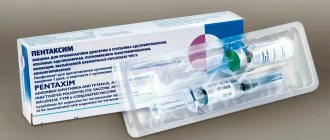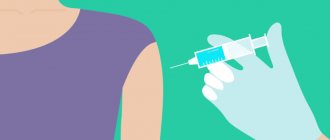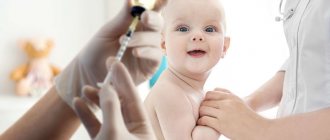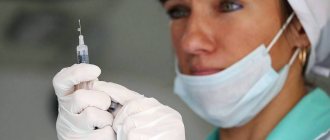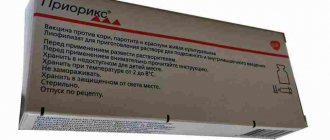Vaccinations.
As a person who has worked for quite a long time in an infectious diseases hospital, I can confidently say: for all diseases against which vaccinations are given, the likelihood of illness remains very real.
Children get sick with these diseases, and the outcomes are, to put it mildly, different. Therefore, for normal, sensible and prudent parents there is and cannot be any discussion about whether vaccinations should be done or not. Definitely do it!
A completely different question is that the response to vaccinations depends very significantly on the state of the child’s body. And if you are very afraid, then the logic is not not to vaccinate. The logic lies in the targeted preparation of the body: a normal lifestyle, natural feeding, hardening, eliminating contact with sources of allergies, etc. Vaccinations must be carried out within the time limits prescribed by the pediatrician, and the more accurate you are, the higher the preventive effectiveness. This should definitely be taken into account when planning, for example, a summer vacation; It would be nice to ask yourself when and what kind of vaccination should be done. Each country in the world has its own calendar of preventive vaccinations approved by the relevant government agency. This calendar takes into account the age of the child, the interval between vaccinations and the list of specific diseases for which vaccinations, in fact, are given. What is the essence of preventive vaccinations? A medical product, a vaccine, is injected into the body. In response to the introduction of a vaccine, the body produces special cells - specific antibodies, which protect a person from the corresponding disease. Each of the vaccines has its own strictly defined indications, contraindications and timing of use, its own schedule and its own routes of administration (orally, intramuscularly, subcutaneously, intradermally). The body reacts differently to each vaccine. In some cases, one vaccination is enough to develop long-term immunity. In others, multiple injections are required. This is where two medical words came from: vaccination and revaccination. The essence of vaccination is to achieve the production of specific antibodies in quantities sufficient to prevent a specific disease. But this starting (protective) level of antibodies gradually decreases, and repeated administrations are necessary to maintain their (antibodies) required amount. These repeated injections of the vaccine are revaccination. The expression we mentioned “reacts differently” refers not only to the quality and timing of the formation of immunity, but also directly to the responses of the child’s body. Reactions that both doctors and parents can directly observe (violation of the general condition, increased body temperature, etc.).
The essence of vaccination
Vaccination is a method of specific disease prevention. After the vaccine is administered, the immune system is activated, the body recognizes and fights pathogens. Antibodies are released that neutralize foreign materials, and immune memory is formed.
Most often, vaccines are administered intramuscularly, less often subcutaneously or orally.
Types of vaccines:
- Alive . The drug contains weakened biological material of the pathogen. After vaccination, symptoms similar to the manifestation of pathology in an erased form occur. Long-term immunity is formed.
- Inactivated. The vaccine contains particles of killed pathogens. After the administration of such a drug, the immune response is not so strong, so short-term immunity is formed.
- Anatoxin . These drugs contain waste products of pathogens.
- Recombinant. A product of genetic engineering, the drug does not contain pathogen materials. But such vaccines are expensive and are not used for free immunization. And it’s difficult to purchase them yourself.
Vaccinations need to be given not only to children, but also to adults.
After primary vaccination, persistent, but not lifelong, immunity is formed; usually protection lasts for 10-15, maximum 20 years.
The severity and likelihood of these reactions are determined by three factors.
The first one - we have already talked about it - is the health status of a particular vaccinated child. The second is the quality and properties of a particular vaccine. All vaccines approved for use (certified) by the World Health Organization (and only such vaccines are used in our country) have high preventive effectiveness, and there is not a single one among them that is obviously bad or of poor quality. Nevertheless, vaccines from different manufacturers can contain different doses of antigens, differ in the degree of purification, and in the type of preservative substances used. In addition, vaccines, even those intended to prevent the same disease, may differ from one another in the most fundamental way - for example, they may be a drug created based on a living but weakened microbe, or a drug based on a killed microbe (or even part this killed microbe). It is clear that if a microbe, although weakened, is alive, there is always a possibility of developing a disease (the very disease for which the vaccine was given), but with a killed microbe there is no such probability. The third factor is the actions of medical workers. Vaccination is not an ordinary standard process, according to the principle “inject everyone at three months,” but individual, very specific and very responsible actions that a specific doctor carries out in relation to a specific child. And these actions are not at all as simple as they might seem at first glance. It is necessary to assess the child’s health, select a vaccine preparation, and give the child’s relatives clear and accessible recommendations on how to prepare the child for vaccination and how to treat him after it (food, drink, air, walking, bathing, medications). It is also very important to scrupulously observe many vaccination subtleties: how to store the vaccine correctly, how to heat it before use, where to inject it, etc.
***
Now a few words about specific vaccinations against specific diseases. The very first vaccination is a vaccination against tuberculosis (the famous anti-tuberculosis vaccine is called BCG). It is usually done directly in the maternity hospital on days 4-7 after birth, once. In the future, theoretically, revaccination is carried out at 7, 12 and 16-17 years. Why theoretically? Yes, because the question of whether or not to revaccinate against tuberculosis largely depends on the Mantoux reaction. This reaction is given to children every year, but the vast majority of parents have no idea what it is or what it is for. The fact is that almost every person sooner or later becomes infected with the tuberculosis bacterium, that is, the microbe enters the human body. But the fact of infection does not at all indicate that a person has contracted tuberculosis. Let’s say a microbe has entered, and the body, thanks to the same vaccination, has a protective amount of antibodies - so the disease does not develop, although the tuberculosis bacterium is present. The Mantoux reaction is not a vaccination, it is a test for infection with tuberculosis. The expression “not a graft, but a test” is very important. After the tests there are no general reactions - the temperature does not rise, the state of health does not change. A local reaction, that is, directly in the place where they were injected, may well be the case; in fact, this is what the test is done for. If there are no tuberculosis bacteria in the body, the test is negative, but after infection it becomes positive. How is all this done in practice? The child is given a Mantoux test every year; it is, of course, negative, but then, at one not-so-wonderful moment, the test turns from negative to positive. Doctors call this the turn of the tuberculin test, and this same turn sooner or later occurs in almost all people, but for one at 3 years old, and for another at 12 or 19. And here a very responsible situation arises. It is necessary to get an answer to a very fundamental question: a person became infected, but did not get sick, naturally because he had immunity, or the infection led to the onset of a disease - there were not enough protective antibodies. Doctors and tuberculosis specialists (TB specialists) answer this question. To do this, the child is examined, certain tests are taken, and, if necessary, a chest x-ray is taken. Depending on the results, the doctor makes an appropriate conclusion. Tuberculosis is detected - we treat tuberculosis, questionable results - a course of preventive treatment with special anti-tuberculosis antibiotics, everything is fine - everything is fine, but revaccination is no longer necessary - anti-tuberculosis immunity will no longer be supported by the vaccine, but by the microbe directly entering the body. And the task of doctors is not to let such a child out of sight, register and regularly examine it in order to promptly identify a situation when the body cannot cope and will still have to be treated. At the age of about 3 months, vaccinations begin directly at the clinic. In three injections with an interval of 1-1.5 months, vaccination against four diseases at once - polio (the vaccine is liquid, it is dripped into the mouth) and whooping cough, diphtheria, tetanus - this is an injection. The vaccine used is called DTP: one drug and against three diseases at once (K - whooping cough, D - diphtheria, C - tetanus). In the second year of life, revaccination against all these diseases is carried out. At one year of age, a vaccination against measles is given, at 15-18 months - against mumps (mumps). The calendar of preventive vaccinations is constantly reviewed. This depends on the epidemic situation, the emergence of new vaccines, and the availability of funds from the state. The modern calendar provides, for example, vaccinations against hepatitis B, but they are hardly given anywhere - there is no money for the vaccine. You can always check with your pediatrician for the exact timing of specific vaccinations.
***
Briefly about the release of Dr. Komarovsky’s School on vaccinations for doubters
During the program, many important aspects were raised, including those related to the shortcomings of the health care system in the country, the active “work” of anti-vaxxers, lack of public awareness, and other things. Since the main topic was “about vaccinations for doubters,” we’ll tell you how Evgeniy Olegovich views this issue.
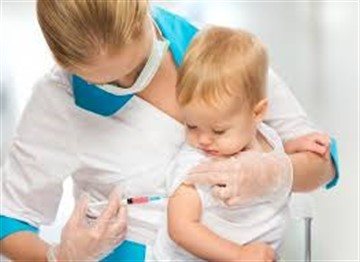
Main points:
- Vaccination is necessary and vital for absolutely all children (excluding a small percentage of those who cannot be vaccinated due to contraindications). Only thanks to mass immunization, many viruses, such as measles, were eradicated from the human population;
- There are no mild childhood illnesses. The mortality rate for the same measles is 1 per 100 cases, which is a fairly high figure;
- the risk of complications after vaccinations, which everyone is so afraid of, really exists, but it is thousands of times lower than when encountering a real infection. The statistics can be cited endlessly. For example, with rubella the risk of meningitis is 1:5000, and with vaccination the chance of getting such a complication is one in a million. And if a pregnant woman gets this infection in the 1st trimester, this leads to fetal deformities and miscarriage in almost 100% of cases;
- Evgeniy Olegovich considers combined vaccines to be one of the greatest achievements of medical science, so if it is possible to get vaccinated with a five-component vaccine, then that’s great. The child’s body does not experience the overload that opponents of vaccination so often write about;
- many parents are wary of the additives found in immunotherapy drugs (aluminum, formaldehyde, and others). The doctor strongly recommends not to be afraid of “scary” words, but to pay attention to chemistry - all additives in vaccines are present in minute quantities and their presence is completely justified. For example, aluminum salts provoke a violent local reaction, promoting the formation of an adequate immune response, and formaldehyde is already contained in the blood of any person, which means that its intake along with an immunotherapy drug is not dangerous;
- If a child has contraindications, then a competent pediatrician should identify them. As a rule, many children, for example, those with allergies, can be vaccinated, but parents believe that they cannot.
How to prepare for vaccination?
There is no need to do anything special. Well, maybe avoid experimenting with food in every possible way - don’t give any new foods. Remember: it is impossible to prepare a healthy child for vaccination with any medicine. Any drugs that supposedly make it easier to tolerate vaccination: “vitamins”, homeopathic remedies, herbs “for blood vessels”, beneficial bacteria, drops “for immunity”, etc., etc. - all these are popular methods of psychotherapy for mom and dad, an attempt implementation of the widespread mental principle “well, something needs to be done” and the business of manufacturers (distributors) of these drugs.
And a few more tips:
- The less stress on the digestive system, the easier the vaccination is tolerable. Never force your child to eat. Don't offer food unless asked. The day before vaccination, limit the volume and concentration of food you eat if possible;
- do not feed (anything) for at least an hour before vaccination;
- When going to the clinic for vaccination, try very, very hard not to overdo it with clothes. It would be extremely undesirable if the vaccine is given to a heavily sweating baby with a lack of fluid in the body. If sweaty people still arrive at the clinic, wait, change clothes, and give them a good drink;
- 3-4 days before vaccination, limit your child’s contact with people (children) as much as possible. Don’t look for infections: if possible, avoid crowded events, shops, public transport, etc.;
- While in the clinic, restrain your sociability. Stand (sit) aside, reduce your contacts. Ideally, put dad in line and take your baby for a walk in the fresh air.
Actions after vaccination
- Walk!!!
- Try to underfeed a little (if you have an appetite) or feed only according to your appetite (if your appetite is reduced or absent).
- Drink more - mineral water, dried fruit compote, green, fruit, berry tea.
- Clean cool moist air.
- Limit communication with people as much as possible - the child develops immunity, his body is busy. Other microbes are undesirable to us now. And the source of these other microbes is other people.
- If the body temperature rises and there is a significant disturbance in the general condition, a doctor’s examination is required, but paracetamol in any form (suppositories, tablets, syrup) can be given. The higher the body temperature, the more relevant the rules set out in paragraphs 2,3 and 4.
